cooling Alfa Romeo MiTo 2013 Owner handbook (in English)
[x] Cancel search | Manufacturer: ALFA ROMEO, Model Year: 2013, Model line: MiTo, Model: Alfa Romeo MiTo 2013Pages: 312, PDF Size: 11.5 MB
Page 63 of 312

PASSENGER COMPARTMENT
VENTILATIONProceed as follows to adjust the ventilation:
❒turn knob A to blue section;
❒press button D to disable internal air recirculation (LED on button
off);
❒turn knob C to
;
❒turn knob B to desired speed.
CLIMATE CONTROL (cooling) (only
present on versions with manual
climate control)To cool, proceed as follows:
❒turn knob A to blue section;
❒press button D to enable internal air recirculation (LED on button
on);
❒turn knob C to
;
❒press button E to turn the climate control system on and turn knob B
to at least 1 (1
stspeed); for faster action, turn knob B to 4 (maximum
fan speed).
Adjusting cooling
❒turn knob A to the right to increase the temperature;
❒press button D to turn internal air recirculation off (circular LED
around the button off);
❒turn knob B to reduce the fan speed.
PASSENGER COMPARTMENT HEATINGFor rapid heating, proceed as follows:
❒turn knob A to the red section;
❒turn knob C to the desired symbol;
❒turn knob B to desired speed.
Rapid heating
For rapid heating, proceed as follows:
❒turn knob A to the red section;
❒press button D to activate internal air recirculation;
❒turn knob C to
;
❒turn knob B to 4(maximum fan speed).
Then use the controls to maintain the desired comfort conditions and
press button D to turn internal air recirculation off (LED on button
off) and to prevent misting.
IMPORTANT When the engine is cold, it takes a few minutes to obtain
rapid heating.
59GETTING TO
KNOW YOUR CARSAFETY
STARTING AND
DRIVING
IN AN EMERGENCY
SERVICING AND
MAINTENANCE
TECHNICAL
SPECIFICATIONS
INDEX
Page 65 of 312

INTERNAL AIR RECIRCULATIONPress button D (
). It is advisable to switch air recirculation on
while standing in traffic or in tunnels to prevent the introduction of
polluted air.
Do not use the function for a long time, particularly if there are many
passengers on board, to prevent the windows from misting up.
IMPORTANT Internal air recirculation makes it possible to reach the
required heating or cooling conditions more quickly depending on the
mode selected. Do not use the air recirculation function on rainy/cold
days as it would considerably increase the possibility of the windows
misting.
SYSTEM MAINTENANCEIn winter, the climate control system must be turned on at least once a
month for about 10 minutes.
Have the system checked by Alfa Romeo Authorized Services before
summer.
61GETTING TO
KNOW YOUR CARSAFETY
STARTING AND
DRIVING
IN AN EMERGENCY
SERVICING AND
MAINTENANCE
TECHNICAL
SPECIFICATIONS
INDEX
Page 67 of 312

DESCRIPTIONThe automatic dual zone climate control system regulates the air
temperatures/distribution in the passenger compartment in two areas:
driver side and passenger side.
The system keeps the passenger compartment comfort level constant
and compensates for any variations in external conditions, including
solar radiation detected by a specific sensor.
The automatically controlled parameters and functions are:
❒air temperature at the driver's/front passenger side vents;
❒air distribution at the driver's/front passenger side vents;
❒fan speed (continuous variation of the air flow);
❒compressor engagement (for cooling/dehumidifying the air);
❒air recirculation.
All these functions can be adjusted manually by operating the system
and selecting one or more functions and modifying their parameters.
Automatic control of the manually changed functions will be
suspended: the system will only override the settings for safety reasons.
Manual selections always have higher priority than automatic settings
and are stored until the AUTO button is pressed, except for cases in
which the system intervenes for safety reasons.
You can adjust one function manually without affecting the automatic
control of the others. The amount of air introduced into the passenger
compartment is not affected by vehicle speed; it is electronically
controlled by a fan.The air temperature is always automatically controlled according to the
temperature set on the display (except for when the system is off or in
certain conditions when the compressor is not running).
The system allows the following to be set or adjusted manually:
❒driver's/passenger side air temperature;
❒fan speed (continuous variation);
❒air distribution to 7 positions (driver/passenger);
❒compressor enabling;
❒rapid defrosting/demisting function;
❒air recirculation;
❒heated rear window;
❒system deactivation.
63GETTING TO
KNOW YOUR CARSAFETY
STARTING AND
DRIVING
IN AN EMERGENCY
SERVICING AND
MAINTENANCE
TECHNICAL
SPECIFICATIONS
INDEX
Page 68 of 312
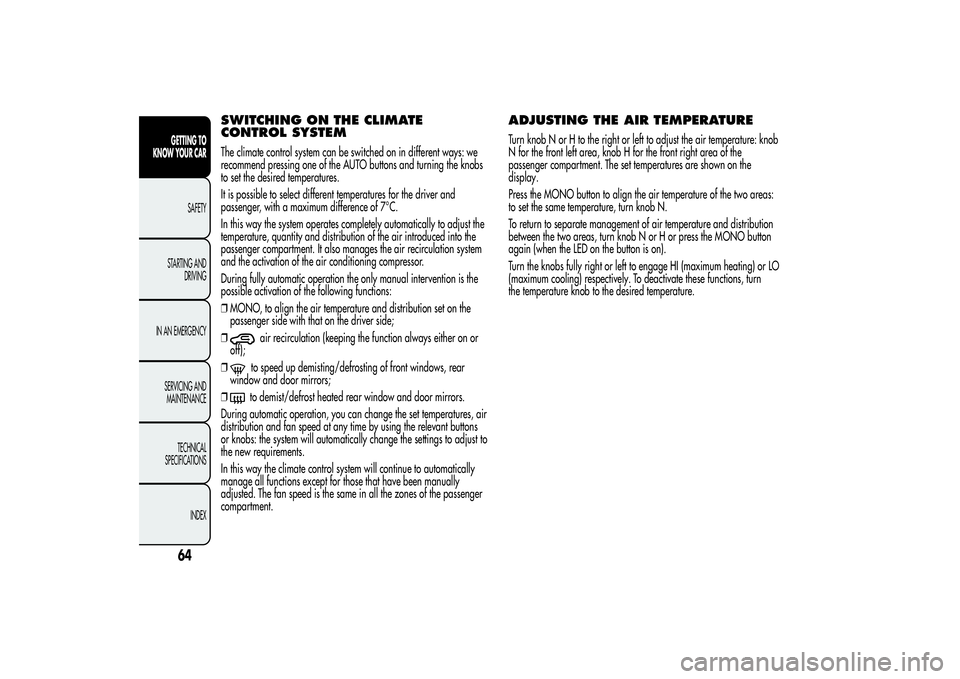
SWITCHING ON THE CLIMATE
CONTROL SYSTEMThe climate control system can be switched on in different ways: we
recommend pressing one of the AUTO buttons and turning the knobs
to set the desired temperatures.
It is possible to select different temperatures for the driver and
passenger, with a maximum difference of 7°C.
In this way the system operates completely automatically to adjust the
temperature, quantity and distribution of the air introduced into the
passenger compartment. It also manages the air recirculation system
and the activation of the air conditioning compressor.
During fully automatic operation the only manual intervention is the
possible activation of the following functions:
❒MONO, to align the air temperature and distribution set on the
passenger side with that on the driver side;
❒
air recirculation (keeping the function always either on or
off);
❒to speed up demisting/defrosting of front windows, rear
window and door mirrors;
❒to demist/defrost heated rear window and door mirrors.
During automatic operation, you can change the set temperatures, air
distribution and fan speed at any time by using the relevant buttons
or knobs: the system will automatically change the settings to adjust to
the new requirements.
In this way the climate control system will continue to automatically
manage all functions except for those that have been manually
adjusted. The fan speed is the same in all the zones of the passenger
compartment.
ADJUSTING THE AIR TEMPERATURETurn knob N or H to the right or left to adjust the air temperature: knob
N for the front left area, knob H for the front right area of the
passenger compartment. The set temperatures are shown on the
display.
Press the MONO button to align the air temperature of the two areas:
to set the same temperature, turn knob N.
To return to separate management of air temperature and distribution
between the two areas, turn knob N or H or press the MONO button
again (when the LED on the button is on).
Turn the knobs fully right or left to engage HI (maximum heating) or LO
(maximum cooling) respectively. To deactivate these functions, turn
the temperature knob to the desired temperature.
64GETTING TO
KNOW YOUR CAR
SAFETY
STARTING AND
DRIVING
IN AN EMERGENCY
SERVICING AND
MAINTENANCE
TECHNICAL
SPECIFICATIONS
INDEX
Page 70 of 312
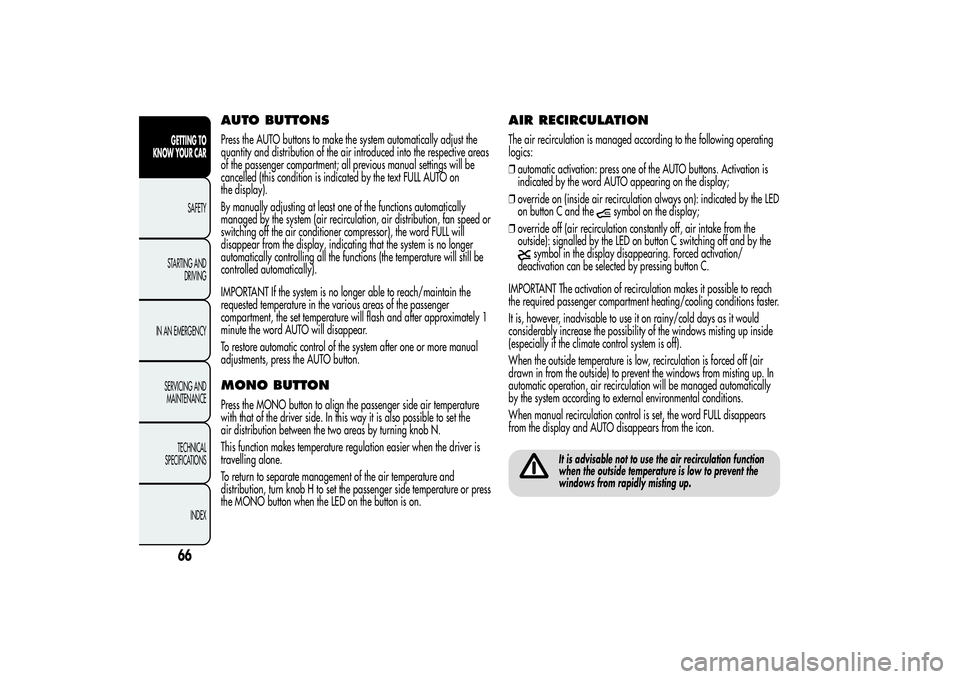
AUTO BUTTONSPress the AUTO buttons to make the system automatically adjust the
quantity and distribution of the air introduced into the respective areas
of the passenger compartment; all previous manual settings will be
cancelled (this condition is indicated by the text FULL AUTO on
the display).
By manually adjusting at least one of the functions automatically
managed by the system (air recirculation, air distribution, fan speed or
switching off the air conditioner compressor), the word FULL will
disappear from the display, indicating that the system is no longer
automatically controlling all the functions (the temperature will still be
controlled automatically).
IMPORTANT If the system is no longer able to reach/maintain the
requested temperature in the various areas of the passenger
compartment, the set temperature will flash and after approximately 1
minute the word AUTO will disappear.
To restore automatic control of the system after one or more manual
adjustments, press the AUTO button.MONO BUTTONPress the MONO button to align the passenger side air temperature
with that of the driver side. In this way it is also possible to set the
air distribution between the two areas by turning knob N.
This function makes temperature regulation easier when the driver is
travelling alone.
To return to separate management of the air temperature and
distribution, turn knob H to set the passenger side temperature or press
the MONO button when the LED on the button is on.
AIR RECIRCULATIONThe air recirculation is managed according to the following operating
logics:
❒automatic activation: press one of the AUTO buttons. Activation is
indicated by the word AUTO appearing on the display;
❒override on (inside air recirculation always on): indicated by the LED
on button C and the
symbol on the display;
❒override off (air recirculation constantly off, air intake from the
outside): signalled by the LED on button C switching off and by the
symbol in the display disappearing. Forced activation/
deactivation can be selected by pressing button C.
IMPORTANT The activation of recirculation makes it possible to reach
the required passenger compartment heating/cooling conditions faster.
It is, however, inadvisable to use it on rainy/cold days as it would
considerably increase the possibility of the windows misting up inside
(especially if the climate control system is off).
When the outside temperature is low, recirculation is forced off (air
drawn in from the outside) to prevent the windows from misting up. In
automatic operation, air recirculation will be managed automatically
by the system according to external environmental conditions.
When manual recirculation control is set, the word FULL disappears
from the display and AUTO disappears from the icon.
It is advisable not to use the air recirculation function
when the outside temperature is low to prevent the
windows from rapidly misting up.
66GETTING TO
KNOW YOUR CAR
SAFETY
STARTING AND
DRIVING
IN AN EMERGENCY
SERVICING AND
MAINTENANCE
TECHNICAL
SPECIFICATIONS
INDEX
Page 156 of 312
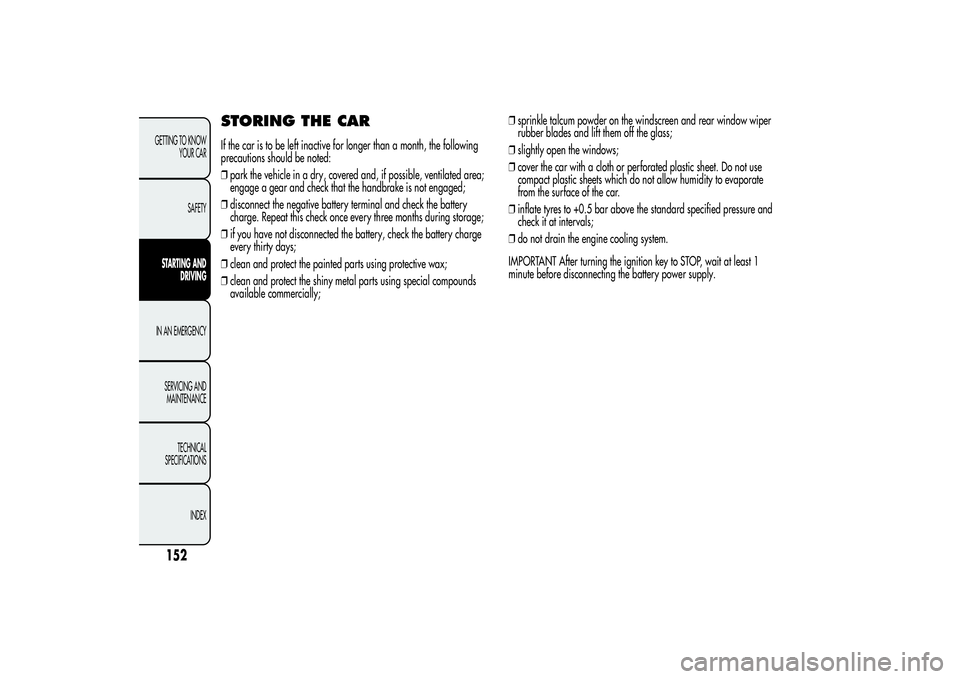
STORING THE CARIf the car is to be left inactive for longer than a month, the following
precautions should be noted:
❒park the vehicle in a dry, covered and, if possible, ventilated area;
engage a gear and check that the handbrake is not engaged;
❒disconnect the negative battery terminal and check the battery
charge. Repeat this check once every three months during storage;
❒if you have not disconnected the battery, check the battery charge
every thirty days;
❒clean and protect the painted parts using protective wax;
❒clean and protect the shiny metal parts using special compounds
available commercially;❒sprinkle talcum powder on the windscreen and rear window wiper
rubber blades and lift them off the glass;
❒slightly open the windows;
❒cover the car with a cloth or perforated plastic sheet. Do not use
compact plastic sheets which do not allow humidity to evaporate
from the surface of the car.
❒inflate tyres to +0.5 bar above the standard specified pressure and
check it at intervals;
❒do not drain the engine cooling system.
IMPORTANT After turning the ignition key to STOP, wait at least 1
minute before disconnecting the battery power supply.
152GETTING TO KNOW
YOUR CAR
SAFETYSTARTING AND
DRIVINGIN AN EMERGENCY
SERVICING AND
MAINTENANCE
TECHNICAL
SPECIFICATIONS
INDEX
Page 192 of 312
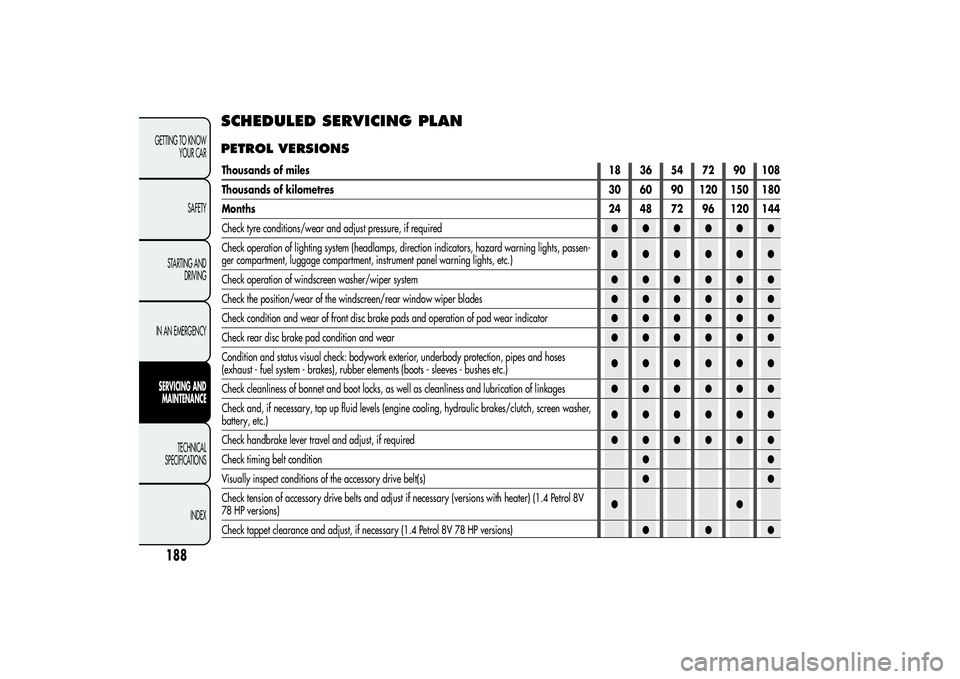
SCHEDULED SERVICING PLANPETROL VERSIONS
188GETTING TO KNOW
YOUR CAR
SAFETY
STARTING AND
DRIVING
IN AN EMERGENCYSERVICING AND
MAINTENANCE
TECHNICAL
SPECIFICATIONS
INDEX
Thousands of miles18 36 54 72 90 108
Thousands of kilometres 30 60 90 120 150 180
Months24 48 72 96 120 144
Check tyre conditions/wear and adjust pressure, if required●●●●●●
Check operation of lighting system (headlamps, direction indicators, hazard warning lights, passen-
ger compartment, luggage compartment, instrument panel warning lights, etc.)●●●●●●
Check operation of windscreen washer/wiper system●●●●●●
Check the position/wear of the windscreen/rear window wiper blades●●●●●●
Check condition and wear of front disc brake pads and operation of pad wear indicator●●●●●●
Check rear disc brake pad condition and wear●●●●●●
Condition and status visual check: bodywork exterior, underbody protection, pipes and hoses
(exhaust - fuel system - brakes), rubber elements (boots - sleeves - bushes etc.)●●●●●●
Check cleanliness of bonnet and boot locks, as well as cleanliness and lubrication of linkages●●●●●●
Check and, if necessary, top up fluid levels (engine cooling, hydraulic brakes/clutch, screen washer,
battery, etc.)●●●●●●
Check handbrake lever travel and adjust, if required●●●●●●
Check timing belt condition●●
Visually inspect conditions of the accessory drive belt(s)●●
Check tension of accessory drive belts and adjust if necessary (versions with heater) (1.4 Petrol 8V
78 HP versions)●●
Check tappet clearance and adjust, if necessary (1.4 Petrol 8V 78 HP versions)●●●
Page 194 of 312
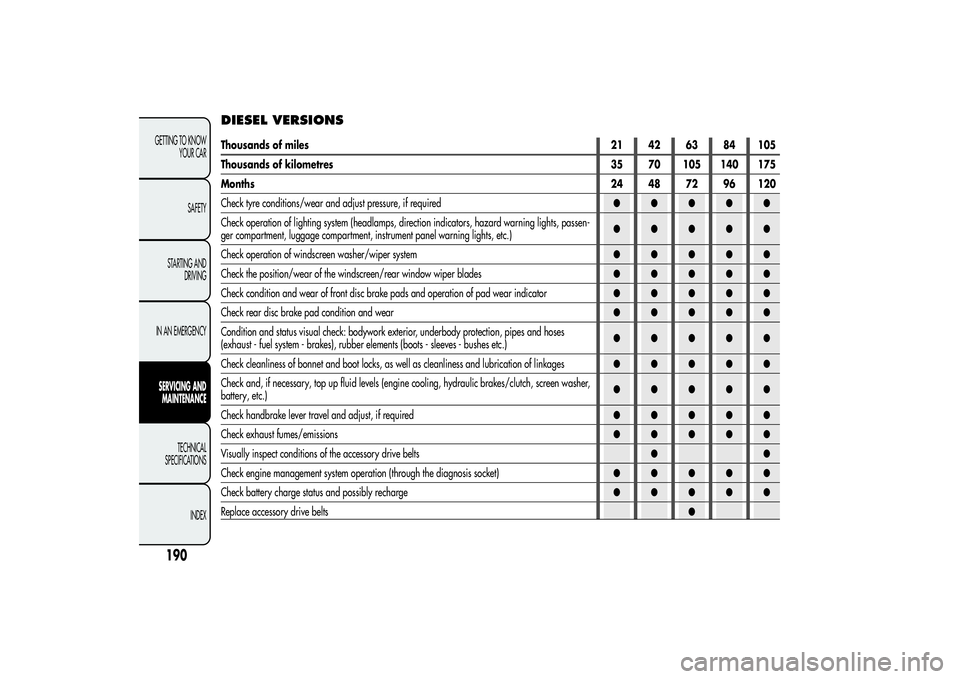
DIESEL VERSIONS
190GETTING TO KNOW
YOUR CAR
SAFETY
STARTING AND
DRIVING
IN AN EMERGENCYSERVICING AND
MAINTENANCE
TECHNICAL
SPECIFICATIONS
INDEX
Thousands of miles21 42 63 84 105
Thousands of kilometres 35 70 105 140 175
Months24 48 72 96 120
Check tyre conditions/wear and adjust pressure, if required●●●●●
Check operation of lighting system (headlamps, direction indicators, hazard warning lights, passen-
ger compartment, luggage compartment, instrument panel warning lights, etc.)●●●●●
Check operation of windscreen washer/wiper system●●●●●
Check the position/wear of the windscreen/rear window wiper blades●●●●●
Check condition and wear of front disc brake pads and operation of pad wear indicator●●●●●
Check rear disc brake pad condition and wear●●●●●
Condition and status visual check: bodywork exterior, underbody protection, pipes and hoses
(exhaust - fuel system - brakes), rubber elements (boots - sleeves - bushes etc.)●●●●●
Check cleanliness of bonnet and boot locks, as well as cleanliness and lubrication of linkages●●●●●
Check and, if necessary, top up fluid levels (engine cooling, hydraulic brakes/clutch, screen washer,
battery, etc.)●●●●●
Check handbrake lever travel and adjust, if required●●●●●
Check exhaust fumes/emissions●●●●●
Visually inspect conditions of the accessory drive belts●●
Check engine management system operation (through the diagnosis socket)●●●●●
Check battery charge status and possibly recharge●●●●●
Replace accessory drive belts●
Page 205 of 312
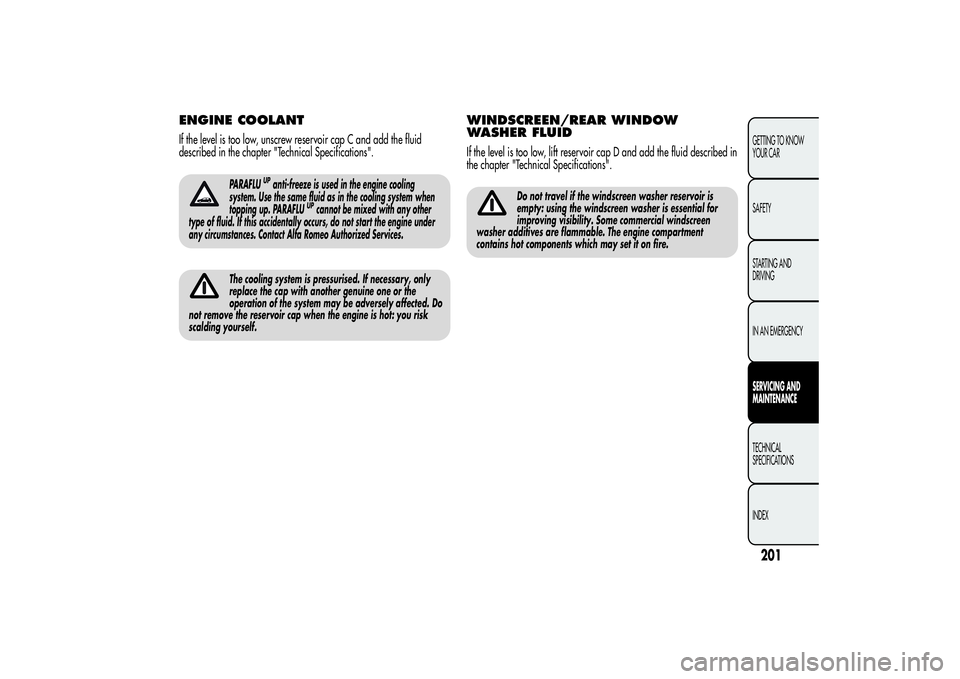
ENGINE COOLANTIf the level is too low, unscrew reservoir cap C and add the fluid
described in the chapter "Technical Specifications".
PARAFLU
UPanti-freeze is used in the engine cooling
system. Use the same fluid as in the cooling system when
topping up. PARAFLU
UPcannot be mixed with any other
type of fluid. If this accidentally occurs, do not start the engine under
any circumstances. Contact Alfa Romeo Authorized Services.
The cooling system is pressurised. If necessary, only
replace the cap with another genuine one or the
operation of the system may be adversely affected. Do
not remove the reservoir cap when the engine is hot: you risk
scalding yourself.
WINDSCREEN/REAR WINDOW
WASHER FLUIDIf the level is too low, lift reservoir cap D and add the fluid described in
the chapter "Technical Specifications".
Do not travel if the windscreen washer reservoir is
empty: using the windscreen washer is essential for
improving visibility. Some commercial windscreen
washer additives are flammable. The engine compartment
contains hot components which may set it on fire.
201GETTING TO KNOW
YOUR CAR
SAFETY
STARTING AND
DRIVING
IN AN EMERGENCYSERVICING AND
MAINTENANCETECHNICAL
SPECIFICATIONS
INDEX
Page 245 of 312
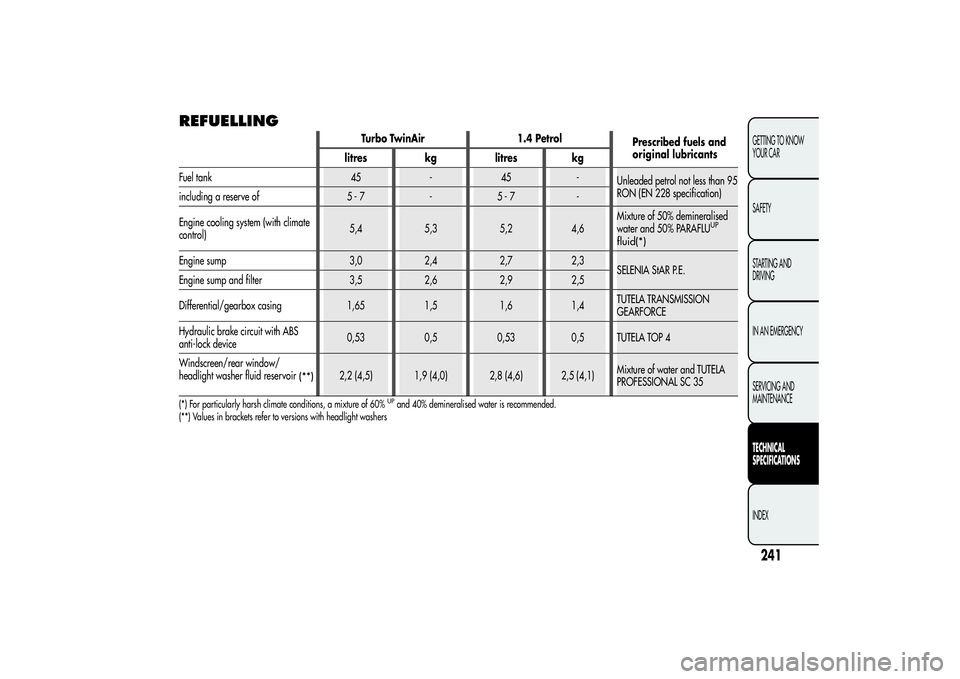
REFUELLING
Turbo TwinAir 1.4 Petrol
Prescribed fuels and
nal lubricants
litres kg litres kg
Fuel tank 45 - 45 -
Unleaded petrol not less than 95
RON (EN 228 specification)
including a reserve of 5 - 7 - 5 - 7 -
Engine cooling system (with climate
control)5,4 5,3 5,2 4,6Mixture of 50% demineralised
water and 50% PARAFLU
UP
Engine sump 3,0 2,4 2,7 2,3
SELENIA StAR P.E.
Engine sump and filter 3,5 2,6 2,9 2,5
Differential/gearbox casing 1,65 1,5 1,6 1,4TUTELA TRANSMISSION
Hydraulic brake circuit with ABS
anti-lock device0,53 0,5 0,53 0,5 TUTELA TOP 4
Windscreen/rear window/
headlight washer fluid reservoir
(**)
2,2 (4,5) 1,9 (4,0) 2,8 (4,6) 2,5 (4,1)Mixture of water and TUTELA
PROFESSIONAL SC 35
(*) For particularly harsh climate conditions, a mixture of 60%
UPand 40% demineralised water is recommended.
(**) Values in brackets refer to versions with headlight washers
241GETTING TO KNOW
YOUR CAR
SAFETY
STARTING AND
DRIVING
IN AN EMERGENCY
SERVICING AND
MAINTENANCETECHNICAL
SPECIFICATIONSINDEX
GEARFORCEorigifluid (*)